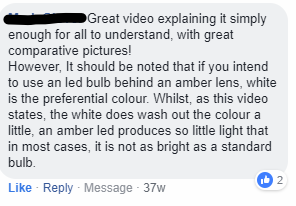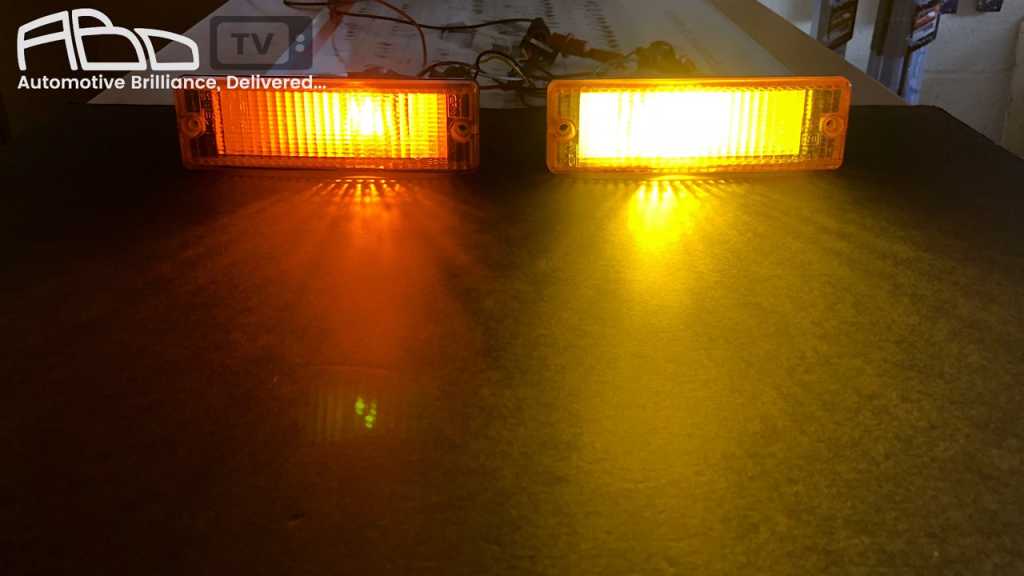Hello and welcome to ABD TV where we aim to answer all of those burning questions, clear up the confusions and leave you brimming with knowledge.
Amber or White LED?
Today we’re answering a comment left on our last video where we looked at whether a red LED would be better than a white LED behind a red lens.
The answer was yes, the red LED is better. If you’ve not seen the video, you should go and check it out.
However I made a sweeping statement in that video where I said…
“When upgrading to LED, go with the colour that the application is for, regardless of whether your standard bulb is white or coloured. This will give you the best and brightest results…”
 After posting the video, we got a very interesting comment suggesting that we were correct about a red LED behind a red lens, but in the case of an Amber lens, you are actually better off with a white led instead of amber.
After posting the video, we got a very interesting comment suggesting that we were correct about a red LED behind a red lens, but in the case of an Amber lens, you are actually better off with a white led instead of amber.
This piqued our interest and we had to check it out.
The Test – Amber Vs White
So we took out 2 amber lensed indicators from a Jaguar XJSC to run our test.
In one, we put a white 382 Twenty20 Cree LED, in the other we put this an Amber one. Let’s see what happened:

In this image, the white LED is installed in the right indicator unit, the Amber LED is in the left.
As you can see, the white LED is actually coming through a bit brighter. It looks a bit exaggerated on the image, the difference isn’t a lot, but the white LED definitely takes the win on brightness alone.
Lumens Dominating First Round
This is because of the white is closer to amber on the colour spectrum than it was when we tested with the red bulbs. Therefore the lens is letting through a higher amount of of the 750 lumens created by the white LED.
The amber bulb still has a respectable 300 lumens, which is all coming through, but it’s just falling short compared with the white bulb.
The Amber LED Fights Back
However, what is also significant is the colour of the light. You can see that the white LED on the right is creating a very washed out light yellow output. While this is bright, it does not have the stand out contrast of a full “orangey” amber bulb.
In contrast, the amber bulb on the left is creating a very orangey amber light. This will be easier to see by other road users, especially in the daytime.
It’s a Split Decision
With this test, we will leave it up to you to decide which is best to go for. Do you prefer the extra brightness of the white LED? or would you prefer the more distinct orange amber light? It is a bit of a trade off and I think this one might divide opinion a bit more. Let us know in the comments below which you prefer.
If you have any questions on this, or have something else you’d like to see us cover in a future ABD TV episode, please put them in the comments below or email us.
Until the next time, take care and be brilliant!
Author: ABD.co.uk

You never comment,that the color of the white LED is 6000 K, and what happened if color of white LED is 3000 K (which is most similar with incandescent light) behind amber lens and behind red lens? In my experiments with 6000 K, the results are similar, but with 3000 K, lumens is what counts most.
Hello, my car has all red glass housing on my tail lights, so my turn signals are red too (US). It just dawned on me that I could possibly make them orange by using a bright yellow bulb, since yellow light mixed with red glass should theoretically produce orange, I think. Has anyone tried this before? Thanks.
I used amber leds for the rear turn signals on my US-spec Porsche 993, and the amber shows through the red lens fine, looking amber when illuminated.
Hey guys, just watched this video.
Interesting information but a better more accurate video would have been showing both lights actually flashing at the same time perhaps in the a vehiclee but also showing the day and night differences you are describing.
Perhaps even taking it further by carrying out the test in bright daylight, dusk and pitch black.
My interest in swapping to led lights is purely due to daylight use, however all lighting conditions would be interesting.
One last thought, would there be a difference in output between an older vehicle lense and a new lense?
Would older lense material and light dissipation patterns have a different result and suit say a modern vehicle over a 20 to 30 year old or even older lense?
I plan to swap out all my vehicle lights both interior courtesy, dash, switch and exterior for LEDs so the more available thorough information the better.
PS. Already swapped my courtesy light bulbs out for your LEDs with massive benefits both in the front, middle and load space lamps.
I am using the white LED for my marker light, and it is significantly more yellow than my turn signal.
I think I will be switching to an amber LED for my marker, when I upgrade my running/turn signal light.
Can us compatible led upgrades would prevent fast flashing results
I like your advice but wondering on a motorcycle with all in one tail/brake and license plate what color to use. Thanks
Surely from a safety viewpoint, you’d want the brighter option of the two because what is the one unique feature that indicators have that no other light has on your car? They FLASH. So with that in mind, you’d want them to be as bright as possible surely, so that other people notice them straight away and are left in no doubt that you’re indicating.
The rear LED indicators on the latest Audis are a different kettle of fish though – anyone else think the pulsating sweep from the inside to the outside of the light cluster is odd/off putting? Or is it just me?…
That is a valid point which is what makes this particular upgrade a bit difficult to say which way to go. It’s probably important to say that the amber bulbs are still bright, just not quite as bright as the white ones.
I just asked everyone in the office and it’s a unanimous dislike to the sweeping indicators on Audi’s and VW’s. It is very odd to see. Perhaps this might change if it becomes more widespread and therefore “normal”.
However it could be said that if the orange of the indicator is too washed out with a bright white LED, a flashing white/orange light instead might also be seen as odd and not immediately apparent that it’s an indicator? Just a thought…
Having said all that, the Twenty20 HF0 range are amber in colour and very bright. A good “best of both Worlds” option :-)
Ah that’s why my LED indicators look almost white! going to swap them for the amber ones :-)